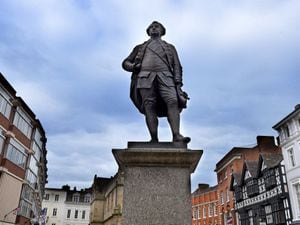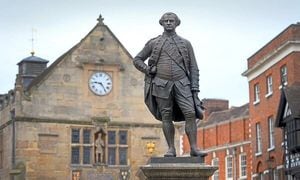Shrewsbury's Robert Clive statue should be kept, says MP
Shrewsbury's MP says he believes the statue of controversial colonialist 'Clive of India' should be retained in the town.

More than 10,000 people have put their names to online petitions calling for the statue of Robert Clive, who helped conquer much of India, to be removed from its plinth at The Square in Shrewsbury.
But nearly 6,000 people have also supported a rival petition, calling for the statue to be retained.
See the petitions here:
Daniel Kawczynski, MP for Shrewsbury and Atcham, said after carrying out his own research into Clive's background he had come to the conclusion the statue should be kept.
He said he would be meeting the organisers of the petitions to have the statue removed over the weekend, and hoped they would be persuaded to withdraw them.
Mr Kawczynski said it was a matter for the council to decide whether or not the statue should be removed, but it was his view that it should be left in situ.
"I believe it needs to be kept for historic purposes," he said.
"We need to ensure that future generations know the history of the area, and I believe that statues are an important part of that history."
He added that he had received a number of letters from constituents on the matter, with the majority being in favour of keeping the statue in the town.
See also:
Mr Kawczynski said he was, though, keen to hear the views of the people behind the petition calling for it to be removed.
He had earlier called for a 'calm debate', and said he wanted to learn more about Clive before making a judgement.
He said that while he would be making his own views known to the council, he would respect whatever decision the authority came to.

Jake Thompson, who launched one of the petitions, said the statue was embarrassing.
He said: “Clive as a symbol of British colonialism is significantly offensive to Indian, Bengali and south-east Asian descent and to attempt to justify it as a celebration of British pride and nationalism is only justifiable if one revels in the persecution and murder of millions of innocent people.”
David Parton, who organised a separate petition calling for the statue to be removed, said: “If we are not comfortable with a statue of Joseph Stalin or Genghis Khan, how can we be comfortable with a statue of Clive?”
But Emma Dolphin, who launched the petition to keep the statue, said: “Removing statues does not change history or help us learn from it.”
In brief: Who was Robert Clive?

Clive was born on the Styche Hall estate, near Market Drayton, in 1725 and went to school in London before travelling to India with the East India Company in 1743.
After two years in Britain, in 1755 Clive returned to India and two years later retook Calcutta (now Kolkata) for the company at the Battle of Plassey, a key moment on Britain's path to controlling Bengal and then India for almost two centuries.
Corruption and looting saw Clive amass a huge amount of wealth and he returned to Britain in 1760, aged 34.
He was made Baron Clive of Passey, knighted and became Shrewsbury's MP, a position he held until his death.
He went back to India in 1765 for two years before returning to Britain where the activities of Clive and the East India Company in India came under sustained attack.
The famine of Bengal that lasted between 1769 and 1773 and killed around a third of the region's population was said to have largely been caused by the company's policies.
Clive defended himself in Parliament, saying "I stand astonished at my own moderation," and in 1773 Parliament declared that he did “render great and meritorious services to his country.”
He died at home in London aged 49 and is believed to have killed himself.
All the petitions can be found by searching ‘Clive of India’ on change.org.
